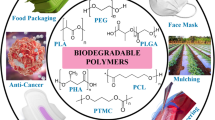Abstract
In this investigation, a series of novel poly(methyl methacrylate-co-N-2-methyl-4-nitrophenylmaleimide) (PMMA-co-MI) copolymers possessing high glass transition temperatures (Tg) and high transparency was prepared through free radical polymerization. The resultant copolymers were characterized by spectroscopic techniques, elemental analysis, X-ray diffraction, and thermal methods. The PMMA-co-MI copolymers demonstrate higher thermal stability as compared to pristine PMMA. The Tg of copolymers is about 40 °C more than for PMMA. The copolymer composition has been determined by elemental analysis and 1H-NMR. The investigated copolymers show excellent solubility in wide range of organic solvents.








Similar content being viewed by others
References
Mallakpour S, Barati A (2012) Preparation and characterization of novel optically active poly(vinyl alcohol-co-vinyl ester) in nonaqueous medium using l-phenylalanine as a chiral material. Amino Acids 42(4):1287–1295. doi:10.1007/s00726-010-0823-9
Tucureanu V, Matei A, Mihalache I, Danila M, Popescu M, Bita B (2015) Synthesis and characterization of YAG:Ce, Gd and YAG:Ce, Gd/PMMA nanocomposites for optoelectronic applications. J Mater Sci 50(4):1883–1890. doi:10.1007/s10853-014-8751-9
Singh AK, Prakash R, Pandey D (2013) A comparative thermal, optical, morphological and mechanical properties studies of pristine and C15A nanoclay-modified PC/PMMA blends: a critical evaluation of the role of nanoclay particles as compatibilizers. RSC Adv 3(35):15411–15420. doi:10.1039/C3RA40543E
Schoth A, Wagner C, Hecht L, Winzen S, Muñoz-Espí R, Schuchmann H, Landfester K (2014) Structure control in PMMA/silica hybrid nanoparticles by surface functionalization. Colloid Polym Sci 292(10):2427–2437. doi:10.1007/s00396-014-3316-7
Gu H, Hou Y, Xu F, Wang S (2015) Electrospinning preparation, thermal, and luminescence properties of Eu2(BTP)3(Phen)2 complex doped in PMMA. Colloid Polym Sci:1–8. doi:10.1007/s00396-015-3614-8
Chau JLH, Hsieh C-C, Lin Y-M, Li A-K (2008) Preparation of transparent silica–PMMA nanocomposite hard coatings. Prog Org Coat 62(4):436–439. doi:10.1016/j.porgcoat.2008.02.005
Su W, Wang S, Wang X, Fu X, Weng J (2010) Plasma pre-treatment and TiO2 coating of PMMA for the improvement of antibacterial properties. Surf Coat Technol 205(2):465–469. doi:10.1016/j.surfcoat.2010.07.013
Schneider M, Michels R, Pipich V, Goerigk G, Sauer V, Heim HP, Huber K (2013) Morphology of blends with cross-linked PMMA microgels and linear PMMA chains. Macromolecules 46(22):9091–9103. doi:10.1021/ma401889k
Feng S, Chen Y, Mai B, Wei W, Zheng C, Wu Q, Liang G, Gao H, Zhu F (2014) Glass transition of poly(methyl methacrylate) nanospheres in aqueous dispersion. Phys Chem Chem Phys 16(30):15941–15947. doi:10.1039/C4CP01849D
Lin C-T, Kuo S-W, Huang C-F, Chang F-C (2010) Glass transition temperature enhancement of PMMA through copolymerization with PMAAM and PTCM mediated by hydrogen bonding. Polymer 51(4):883–889. doi:10.1016/j.polymer.2009.12.039
Gianotti V, Antonioli D, Sparnacci K, Laus M, Giammaria TJ, Ferrarese Lupi F, Seguini G, Perego M (2013) On the thermal stability of PS-b-PMMA block and P(S-r-MMA) random copolymers for nanopatterning applications. Macromolecules 46(20):8224–8234. doi:10.1021/ma401023y
Kuo S-W, Xu H, Huang C-F, Chang F-C (2002) Significant glass-transition-temperature increase through hydrogen-bonded copolymers. J Polym Sci Part B: Polym Phys 40(19):2313–2323. doi:10.1002/polb.10292
Manseri A, David G, Joly-Duhamel C, Boutevin B (2010) Synthesis of glutarimides from PMMA copolymers, part 3: use of functional amines. J Appl Polym Sci 118(4):1867–1871. doi:10.1002/app.32562
Jagan Mohan D (2013) Synthesis, characterization and swelling properties of copolymers of N(−1,1-dimethyll-3-oxobutyl)acrylamide with methyl methacrylate. Des Monomers Polym 17(5):438–444. doi:10.1080/15685551.2013.867567
Liu W-D, Zhang Y-H, Fang L-F, Zhu B-K, Zhu L-P (2012) Antifouling properties of poly(vinyl chloride) membranes modified by amphiphilic copolymers P(MMA-b-MAA). Chin J Polym Sci 30(4):568–577. doi:10.1007/s10118-012-1153-z
Hendrana S, Hill DJT, Senake Perera MC, Pomery PJ (2001) Copolymerization of methyl methacrylate and allyl acetate Part I. Rate of reaction. Polym Int 50(5):597–605. doi:10.1002/pi.671
Teodorescu M (2002) Free-radical copolymerization of methyl methacrylate with styrene in the presence of 2-mercaptoethanol II. Influence of methyl methacrylate/styrene ratio. Eur Polym J 38(5):841–846. doi:10.1016/S0014-3057(01)00251-8
Koike K, Araki T, Koike Y (2014) Influence of dielectric fluctuation on light-scattering properties of random copolymers in bulk. Polymer 55(11):2697–2703. doi:10.1016/j.polymer.2014.04.009
Szanka A, Szarka G, Iván B (2013) Multi-methacrylated star-shaped, photocurable poly(methyl methacrylate) macromonomers via quasiliving ATRP with suppressed curing shrinkage. Polymer 54(22):6073–6077. doi:10.1016/j.polymer.2013.09.025
Bakhshi H, Zohuriaan-Mehr MJ, Bouhendi H, Kabiri K (2009) Spectral and chemical determination of copolymer composition of poly (butyl acrylate-co-glycidyl methacrylate) from emulsion polymerization. Polym Test 28(7):730–736. doi:10.1016/j.polymertesting.2009.06.003
Licoccia S, Trombetta M, Capitani D, Proietti N, Romagnoli P, Di Vona ML (2005) ATR–FTIR and NMR spectroscopic studies on the structure of polymeric gel electrolytes for biomedical applications. Polymer 46(13):4670–4675. doi:10.1016/j.polymer.2005.03.078
Zhang F-A, Song C, Yu C-L (2011) Effects of preparation methods on the property of PMMA/SBA-15 mesoporous silica composites. J Polym Res 18(6):1757–1764. doi:10.1007/s10965-011-9582-x
Nakano T, Mori M, Okamoto Y (1993) Stereospecific radical polymerization of 1-phenyldibenzosuberyl methacrylate affording a highly isotactic polymer. Macromolecules 26(4):867–868. doi:10.1021/ma00056a049
Ferriol M, Gentilhomme A, Cochez M, Oget N, Mieloszynski JL (2003) Thermal degradation of poly(methyl methacrylate) (PMMA): modelling of DTG and TG curves. Polym Degrad Stab 79(2):271–281. doi:10.1016/S0141-3910(02)00291-4
Holland BJ, Hay JN (2002) The effect of polymerisation conditions on the kinetics and mechanisms of thermal degradation of PMMA. Polym Degrad Stab 77(3):435–439. doi:10.1016/S0141-3910(02)00100-3
Carvalho HWP, Suzana AF, Santilli CV, Pulcinelli SH (2014) Structure and thermal behavior of PMMA–polysilsesquioxane organic–inorganic hybrids. Polym Degrad Stab 104(0):112–119. doi:10.1016/j.polymdegradstab.2014.03.031
Kao H-C, Kuo S-W, Chang F-C (2003) Effects of inert diluent segment and hydrogen bonding in poly(styrene-co-methacrylamide) copolymers. J Polym Res 10(2):111–117. doi:10.1023/A:1024978102847
Acknowledgments
We wish to express our gratitude to the Research Affairs Division Malek-ashtar University of Technology (MUT), Shahin-shahr, for partial financial support. We also like to thank Mr. M. salari for valuable helps.
Author information
Authors and Affiliations
Corresponding author
Electronic supplementary material
Below is the link to the electronic supplementary material.
ESM 1
(DOC 272 kb)
Rights and permissions
About this article
Cite this article
Atabaki, F., Abdolmaleki, A. & Barati, A. Free radical copolymerization of methyl methacrylate and N-2-methyl-4-nitro-phenylmaleimide: Improvement in the Tg of PMMA. Colloid Polym Sci 294, 455–462 (2016). https://doi.org/10.1007/s00396-015-3799-x
Received:
Revised:
Accepted:
Published:
Issue Date:
DOI: https://doi.org/10.1007/s00396-015-3799-x




